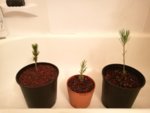mikejungle
Seedling
Hello y'all, noob in need of advice. Done a lot of reading over the past few days, but I need a little tailored help.
Got these three seedlings, and I just need general growing advice. Almost don't even care if they're the right shape for bonsai, but wanna make sure I do what I can to see if they do.
L-->R
Bristlecone, Giant Sequoia, Black Pine

Soil:
I've read so many soil threads here, and I decided to follow Adair's advice about sticking to inorganic. Currently unemployed, so this is a super budget, ad hoc setup. I bought a bag of lava rocks, and spent the afternoon pounding that, and some clay balls from IKEA to get what you see in the BC pot. I figured BC woildnt do as well with some organic soil mixed in, so I potted it first.
Not the most consistent size, some large chunks in there, but sieved for fine particles.
BP, and Sequoia, I mixed in some cactus soil, because I realized I was going to run low on substrate.
So...acceptable, or do I need to amend the setup? I can spend a little more if necessary, just want to know if it's good enough, at the moment.
Weathering:
Where the heck do I put these guys? I read that dormancy is necessary, but too cold could be bad, plus I just potted them...
I got the terracotta pot, because the Lowe's I went to didn't have enough nursery pots. I live a little north of Chicago, and it hit 19 F last night, so I just don't know what to do.
Don't know whether I should stick them in the garage over the winter, keep them indoors at night and outdoors during the day, or just straight outdoors.
Watering: chopstick method ok? Don't know how often it will be, yet. I watered them completely after potting, and they are sitting in the tub draining.
Fertilization: either osmocote or miracle grow? Follow directions? I read that I should wait a few weeks before the initial fertilization after potting, so I'm waiting.
Brown needles: all came in the mail with a few brown needles, but BC has a bunch a little lower. Should I be worried? Should I pick them off or let them fall off? Read a bunch about contributing factors, but it's impossible to tell what contributed to its browning.
Shaping:
Do I even need to concern myself with this at the moment? I know that attention to nebari is important, but I think the 2 gallon pots are good enough, right?
Might transplant the Sequoia if y'all think I need to, but most of the Sequoia I've seen have fatass trunks.
I think they're too young for wiring or pruning, but please tell me if I'm wrong!
I know I have more questions, but this is a hearty kickoff. Thanks in advance for the help!
Got these three seedlings, and I just need general growing advice. Almost don't even care if they're the right shape for bonsai, but wanna make sure I do what I can to see if they do.
L-->R
Bristlecone, Giant Sequoia, Black Pine

Soil:
I've read so many soil threads here, and I decided to follow Adair's advice about sticking to inorganic. Currently unemployed, so this is a super budget, ad hoc setup. I bought a bag of lava rocks, and spent the afternoon pounding that, and some clay balls from IKEA to get what you see in the BC pot. I figured BC woildnt do as well with some organic soil mixed in, so I potted it first.
Not the most consistent size, some large chunks in there, but sieved for fine particles.
BP, and Sequoia, I mixed in some cactus soil, because I realized I was going to run low on substrate.
So...acceptable, or do I need to amend the setup? I can spend a little more if necessary, just want to know if it's good enough, at the moment.
Weathering:
Where the heck do I put these guys? I read that dormancy is necessary, but too cold could be bad, plus I just potted them...
I got the terracotta pot, because the Lowe's I went to didn't have enough nursery pots. I live a little north of Chicago, and it hit 19 F last night, so I just don't know what to do.
Don't know whether I should stick them in the garage over the winter, keep them indoors at night and outdoors during the day, or just straight outdoors.
Watering: chopstick method ok? Don't know how often it will be, yet. I watered them completely after potting, and they are sitting in the tub draining.
Fertilization: either osmocote or miracle grow? Follow directions? I read that I should wait a few weeks before the initial fertilization after potting, so I'm waiting.
Brown needles: all came in the mail with a few brown needles, but BC has a bunch a little lower. Should I be worried? Should I pick them off or let them fall off? Read a bunch about contributing factors, but it's impossible to tell what contributed to its browning.
Shaping:
Do I even need to concern myself with this at the moment? I know that attention to nebari is important, but I think the 2 gallon pots are good enough, right?
Might transplant the Sequoia if y'all think I need to, but most of the Sequoia I've seen have fatass trunks.
I think they're too young for wiring or pruning, but please tell me if I'm wrong!
I know I have more questions, but this is a hearty kickoff. Thanks in advance for the help!
